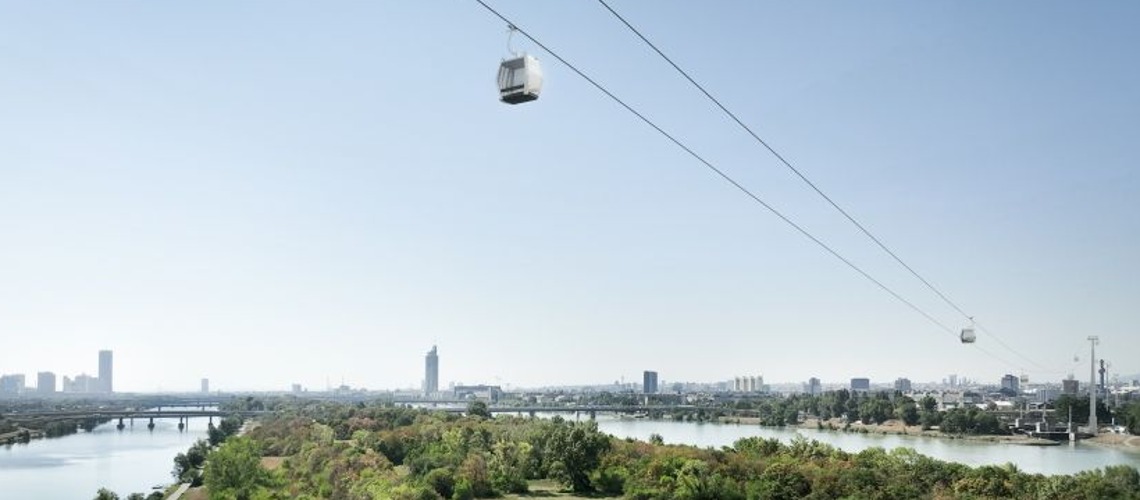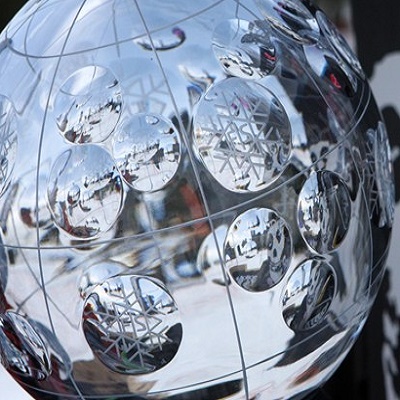Leitner Implements Vienna Kahlenberg Cable Car Project

The Kahlenberg cable car project enables environmentally friendly development of the local recreation areas Donauinsel Nord and Kahlenberg and will thus offer – in addition to an important tourist attraction for Vienna – a modern mobility offer in urban areas for all Viennese in the future.
A well thought-out traffic planning concept – and climate-neutral
Starting from the valley station at the U4 in Heiligenstadt, the Kahlenberg cable car runs a total distance of 5.7 kilometers across the Danube in just six minutes to the Donauinsel Nord station, from where it goes to Strebersdorf and finally up to the Kahlenberg mountain station.
Due to the direct connection to the U4 Heiligenstadt, you can largely avoid driving your own car. Floridsdorf gets a direct connection to the U4 station Heiligenstadt. The project will ultimately relieve traffic in Döbling and close the gap in the public transport connection on the northern side of the Danube bank. In the Strebersdorf station, there will be a Park & Ride facility with 630 parking spaces in a completely landscaped multi-storey car park and a Bike & Ride station with around 1,000 bike boxes and e-bike charging stations for commuters and visitors from outside Disposal.
According to independent reports, the Kahlenberg cable car can be expected to reduce motorized private transport and annual CO2 emissions up to the Kahlenberg by up to 50 percent. Instead, the cable car takes less than 20 minutes from Heiligenstadt to the Kahlenberg - and it's completely climate-neutral. Due to the low land use and the unsealing of the Kahlenberg car park, the construction project even has a positive unsealing balance.
The project operator and the required condition
Behind the Kahlenberg cable car is the Austrian Genial Tourismus- und Projektentwicklungs-GmbH, which is owned by the builders of the popular Kahlenberg Adventure World (including forest rope park, 3D archery course), for whom the reduction of motorized individual traffic on the Kahlenberg is a major concern. The construction costs will be around 70 million euros. The project is being implemented by one of the world's largest cable car manufacturers, LEITNER AG from South Tyrol, and the general planner for the Kahlenberg cable car is the well-known architectural office WGA ZT GmbH from Vienna.
The concession for the realization of the project, which was granted in March 2022, is based on a comprehensive examination and weighing of interests, for which the BVwG obtained a total of 14 independent reports. The project was decided to be in the public interest, in particular due to the reduction in traffic volume, improved access to local recreation areas and the positive economic effects for tourism in Vienna.
Possible concerns were also examined in detail. In the course of the BVwG reports, it was determined, among other things, that the project is not associated with any threat to animals, plants or water. Furthermore, as part of the concession process, the UNESCO Chair in "Cultural Heritage and Tourism" determined that no lines of sight of the World Heritage Site are affected and stated that the journey across the Danube and the associated panoramic view will certainly be something unique for Vienna.
The project planning and structural measures including unsealing
Due to its modular design, the system can not only be set up quickly, in a planned construction time of approx. ten months, but also with only very little interference with nature. Because the stations of the Kahlenberg cable car and the majority of the supports will be built primarily on surfaces that are already sealed. Only three supports are erected in the commercial forest area of the Kahlenberg and each only requires an area of 2 x 4 meters. The core or protection zone of the biosphere park (below the Leopoldsberg) remains completely untouched. In the course of the construction work, no construction roads are necessary and no trees have to be felled for rescue lanes along the course of the railway. The supports as well as the station buildings of the cable car are consistently integrated into the landscape.
Throughout the project planning, the project operator paid careful attention to ensuring that residents would not be adversely affected by the cable car. In particular, the route was chosen so that it does not cross any inhabited properties. In addition to the Jedleseer allotments, the route of the cable car runs behind the existing noise protection wall and up to the Kahlenberg at a great height below the Leopoldsberg next to the Kahlenberger village. Here too, there are no impairments to the privacy of the residents. The project objections from the residents of the Kahlenberger Dorf were taken into account in the early planning phase, so the station that was originally planned near the Kahlenberger Dorf will not be implemented.
Ultimately, the Kahlenberg cable car project with the planned demolition of the previous huge car park at the mountain station, including the corresponding unsealing and greening, is also a landscape project. This ecological aspect of the project is to be further strengthened with the biosphere information and experience center integrated into the mountain station.
State-of-the-art technology becomes an experience
The 115 state-of-the-art ten-person cabins have an infotainment system, video surveillance and an intercom system to the station. And they offer enough space for prams, bicycles and wheelchairs and thus enable a barrier-free, fast and environmentally friendly way for those looking for relaxation to the northern Danube island.
Ultimately, the Kahlenberg cable car will offer a breathtaking panoramic view in the future. Floating above the Vienna Woods Biosphere Park, below the Leopoldsberg church, passengers can experience a view of Vienna – and if visibility is good even as far as Schneeberg and Bratislava.
Numerous international successful projects, such as in London, Sarajevo, Koblenz, Barcelona, Ankara, Singapore, Moscow and many more, demonstrate the advantages of urban cable cars as an environmentally friendly, traffic-reducing means of transport. With the Kahlenberg cable car, the cosmopolitan city of Vienna will also be able to offer this modern, sustainable form of mobility in the future.
Technical specifications
- Total track length: 5.6 km
- Travel time (entire route): 19:56 min.
- driving speed: 21.6 km/h = 6 m/s
Operating volume:
- < 65 dB specification of railway law
- < 50 dB in directly connected neighborhood
- Number of cabins: 115
- Cabin size: 10 people
- Capacity (carrying capacity): 1,800 people/hour
- Conveyor speed: one car every 20 seconds
- Cable car model: monocable gondola
- Number of supports: 23
- Park & Ride pitches: 630
- Bike & Ride parking spaces: around 1,000
Cabin Equipment
- Interior lighting (dimmed for an unrestricted view of the outside)
- All cabins under video surveillance
- Free WIFI
- Infotainment system
- Direct connection to the control center
- women's cabins
- Folding bench seats with fabric covers
- All-round polycarbonate glazing
- Level adjuster entry and exit
- Suitable for wheelchairs and prams (door opening approx. 820mm)














